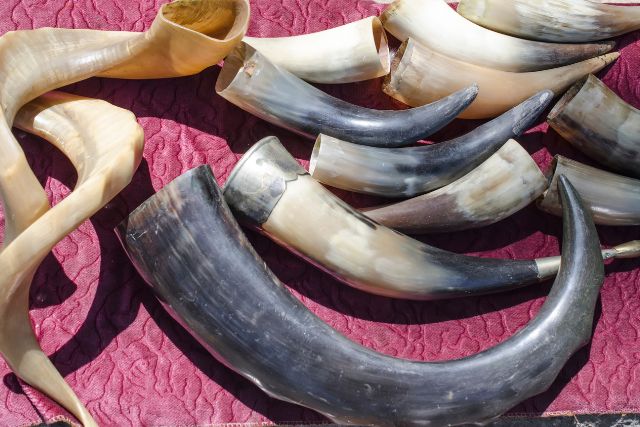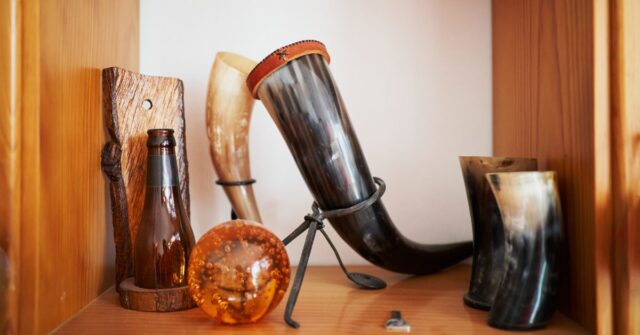Greetings, Viking enthusiasts and historical artifact aficionados! Have you ever gazed upon a drinking horn and wondered about its tales of yore?
Or perhaps you’re pondering how to discern a high-quality horn that Odin himself would nod in approval of?
Fear not, for you’re about to embark on a voyage through the ages, unraveling the secrets of these storied vessels.
The Rich History of Drinking Horns
Drinking horns hold a place of honor in the annals of history, their legacy steeped in the mead and blood of ancient cultures.
But it was the Vikings who elevated the drinking horn from a mere container to a symbol of power and fellowship.

Origins and Ancient Uses
Long before the Vikings set sail, drinking horns were in use across different cultures, from the Scythians to the Celts.
Crafted from bovine horns and often adorned with metalwork, these early versions were both practical and decorative.
Cultural Significance Among Vikings
For Vikings, the drinking horn was not just for quaffing mead. It was a ceremonial object, a mark of status, and an integral part of their social and religious rituals.
Legends tell of horns that could only be lifted by the worthy, intertwining them with the fabric of Norse Mythology.
Modern Revival and Interest
Today, the allure of drinking horns transcends historical reenactment. They’ve found a place in modern homes and gatherings, where they add a dash of ancient charm and serve as a conversation starter.
Understanding the Basics of Drinking Horns
Before diving into the quest for a high-quality drinking horn, it’s essential to grasp what sets these vessels apart.
Materials Used in Construction
True drinking horns are fashioned from the horns of bovines, such as cows or buffalo. Each horn is unique, with variations in color, shape, and size, adding to its charm.

Types and Styles
From the simple, unadorned horn to elaborate pieces fitted with metal stands and intricate carvings, drinking horns can range from rustic to regal.
Size and Capacity Variations
Size matters, especially when it comes to drinking horns. They can vary widely, from small horns suitable for a nip of mead to grand ones designed for communal toasts.
Criteria for High-Quality Drinking Horns
Not all horns are created equal. Here’s what to look for to ensure you’re getting a piece worthy of a Viking chieftain.
Material Quality and Source
A top-notch drinking horn begins with high-quality material. Ethically sourced horns, free of cracks and blemishes, are the foundation of a superior vessel.
Craftsmanship and Authenticity
The difference between a good horn and a great one lies in the craftsmanship. Authentic, handcrafted horns that pay homage to traditional methods are the gold standard.
Finish and Aesthetics
The finish of a drinking horn speaks volumes about its quality. Look for smooth interiors sealed with food-safe materials and exteriors that highlight the natural beauty of the horn.

Functional Design Considerations
A well-designed horn is not just a showpiece; it’s fully functional. Consider how it feels in your hand and whether it’s balanced for a comfortable drinking experience.
Spotting Authenticity and Avoiding Fakes
With the popularity of drinking horns, fakes have flooded the market. Here’s how to spot the genuine article.
Signs of Authentic Historical Replicas
Genuine replicas will often come with documentation or evidence of authenticity, such as information about the historical period they replicate and the methods used in their creation.
Common Traits of Low-Quality or Fake Horns
Beware of horns made from plastic or other synthetic materials masquerading as the real deal. A lack of natural imperfections is a dead giveaway.
Verifying Seller and Manufacturer Credentials
Do your homework. Reputable sellers and craftsmen will be transparent about their sources and processes, and often proud to share their heritage and expertise.
Preservation and Maintenance of Drinking Horns
A drinking horn is not just a vessel; it’s a companion through time. Here’s how to keep yours in tip-top shape for generations.
Cleaning and Care Best Practices
To keep your horn in pristine condition, wash it by hand with warm water and a mild soap. Steer clear of dishwashers and harsh chemicals, which can damage the horn’s natural surface.

Storage Tips for Longevity
When not in use, store your horn in a cool, dry place away from direct sunlight. A display stand not only showcases its beauty but also ensures it retains its shape and integrity.
Restoration Tips for Antique Horns
Antique horns might require a bit of tender loving care. Minor scratches can be buffed out, while cracks need professional attention. Regular oiling with food-safe mineral oil can restore the luster of old horns.
Where to Find and Purchase High-Quality Horns
So, where can a budding Viking or historical enthusiast find these treasures? Here’s the scoop on scoring a high-quality drinking horn.
Recommended Vendors and Artisans
Look for artisans who specialize in historical crafts. Markets, fairs, and online stores (like ours) dedicated to medieval or Viking reenactments are great starting points.
Attending Historical and Cultural Events
Historical reenactments, Viking festivals, and medieval fairs are not only fun but also treasure troves for authentic drinking horns. Plus, you get the added benefit of seeing them up close and personal.

Online Resources and Communities
Online forums and communities focused on Viking culture or historical reenactment are gold mines of information on where to purchase authentic drinking horns.
Integrating Drinking Horns into Modern Life
Believe it or not, drinking horns fit seamlessly into contemporary life. Here’s how to make your horn more than a novelty.
As Functional Drinkware
Why not sip your favorite brew from a drinking horn during your next game night or TV binge? It’s a surefire conversation starter and adds an element of old-world charm.
Decorative Uses
Even when not in use, a drinking horn makes for an intriguing decorative piece. Display it on a mantle or shelf, or use it as part of a centerpiece at your next feast.
Part of Viking Reenactments and Festivals
If you’re into reenactments or attend Viking festivals, a drinking horn is practically a must-have accessory. It adds authenticity to your outfit and enhances the overall experience.

FAQs About Drinking Horns
Got questions? Here are answers to some common queries about drinking horns.
Are Drinking Horns Safe?
Yes, when properly sealed and cared for, drinking horns are safe for use with cold and room-temperature beverages. Just remember, they’re not suitable for hot liquids unless they have been specially treated.
Can Drinking Horns Be Personalized?
Absolutely! Many artisans offer personalization options, from engravings to special finishes, making your horn a one-of-a-kind piece.
How to Tell the Age of a Drinking Horn?
Determining the exact age can be tricky without historical context. However, craftsmanship, material, and design can offer clues. Experts and enthusiasts in historical forums can often provide insights.

Conclusion: The Art of Appreciating Drinking Horns
Embarking on the journey to find and cherish a high-quality drinking horn is an adventure in itself, a blend of history, craftsmanship, and personal taste.
Whether you’re toasting at a festival, decking out your abode, or diving into the Viking lifestyle, a drinking horn adds a dash of ancient mystique to modern life.
So, raise your horn, make a toast to the past, and sip in the spirit of the Vikings. Skål!










